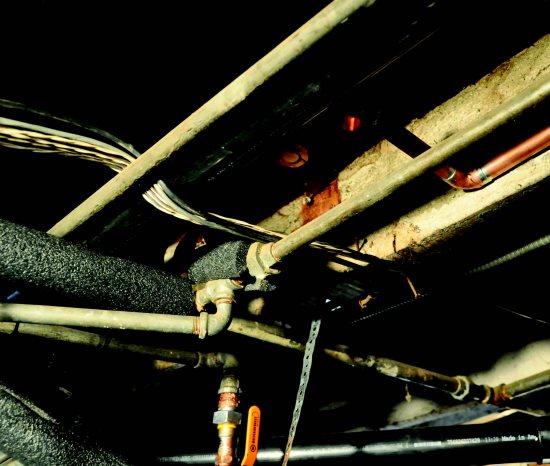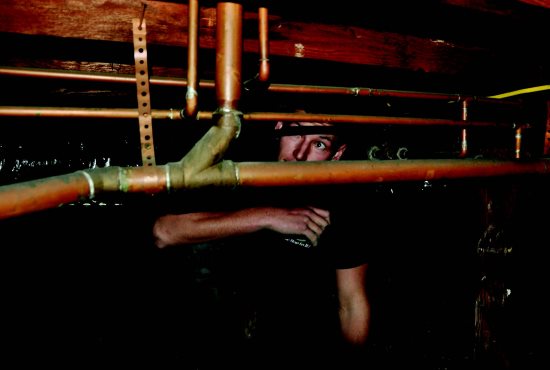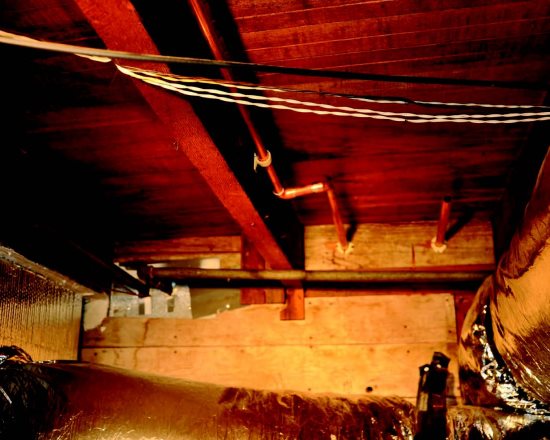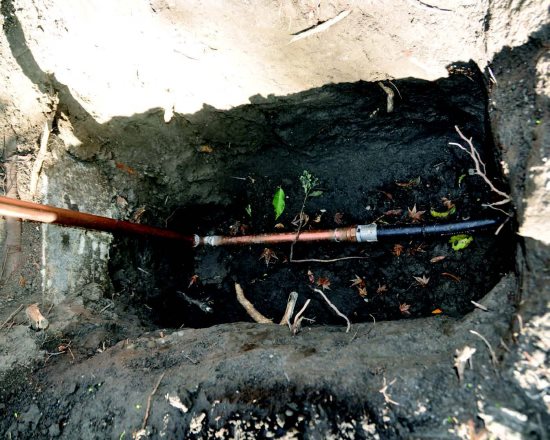 | | | Top right, a new copper pipe is installed to replace the aged pipes. Photo Andy Scheck | | | | | | Plumbing runs largely unseen through our homes, serving to bring us comfort and cleanliness. "Plumb' is from the Latin "plumbum" for lead, because in the early days of plumbing that's the material that was used for piping. Lead was cheap, easy to form, easy to solder, long-lasting - and extremely poisonous.
 According to the Centers for Disease Control and Prevention, "low levels of exposure have been linked to damage to the central and peripheral nervous system, learning disabilities, shorter stature, impaired hearing, and impaired formation and function of blood cells." As the dangers of using lead - severe brain and nervous system damage, especially but not only in children - reared their ugly heads into public awareness, better materials were developed to safely carry the precious water we use.
According to the Centers for Disease Control and Prevention, "low levels of exposure have been linked to damage to the central and peripheral nervous system, learning disabilities, shorter stature, impaired hearing, and impaired formation and function of blood cells." As the dangers of using lead - severe brain and nervous system damage, especially but not only in children - reared their ugly heads into public awareness, better materials were developed to safely carry the precious water we use.
 Brass, copper, stainless steel, galvanized steel, "black" steel, iron, baked clay, cementitious compounds and, more recently, different types of plastic can all be found within many, and often the same, houses. All of these materials have different lifespans, different strengths and weaknesses, different handling rules, different health questions, different uses, and different costs.
Brass, copper, stainless steel, galvanized steel, "black" steel, iron, baked clay, cementitious compounds and, more recently, different types of plastic can all be found within many, and often the same, houses. All of these materials have different lifespans, different strengths and weaknesses, different handling rules, different health questions, different uses, and different costs.
 Knowing whether or not a pipe repair or replacement is needed, and how much is a reasonable cost, is not always easy, especially for a young family with the stresses of a house purchase and a new baby all at the same time.
Knowing whether or not a pipe repair or replacement is needed, and how much is a reasonable cost, is not always easy, especially for a young family with the stresses of a house purchase and a new baby all at the same time.
 Lafayette residents Steven and Becky Barnstetter had to replace their home's sewer line four years ago. As with many loans, the bank required repairs to protect their investment, but there was an unpleasant surprise on top of that expectation: "In order to get the loan we had to spend about $56,000 to lift the house, but a city inspector said the sewer also needed to be replaced," Steven Barnstetter said. "We had it inspected, but it didn't have separations or holes." The pipe had been checked with a borescope (a camera that is sent through the interior of a pipe).
Lafayette residents Steven and Becky Barnstetter had to replace their home's sewer line four years ago. As with many loans, the bank required repairs to protect their investment, but there was an unpleasant surprise on top of that expectation: "In order to get the loan we had to spend about $56,000 to lift the house, but a city inspector said the sewer also needed to be replaced," Steven Barnstetter said. "We had it inspected, but it didn't have separations or holes." The pipe had been checked with a borescope (a camera that is sent through the interior of a pipe).
 The inspector had come to check on legitimate repairs that the Barnstetters had permits for, and that's when he spotted a waste pipe extension that the original homeowner had jerry-rigged for an additional bathroom without permits. Both Barnstetters recall the man saying he was a city of Lafayette inspector. "He told us that the city of Lafayette would come and pour concrete down it if we didn't get it fixed, so we'd never be able to use it!" said Becky. Alarmed, she ran to apply for permits.
The inspector had come to check on legitimate repairs that the Barnstetters had permits for, and that's when he spotted a waste pipe extension that the original homeowner had jerry-rigged for an additional bathroom without permits. Both Barnstetters recall the man saying he was a city of Lafayette inspector. "He told us that the city of Lafayette would come and pour concrete down it if we didn't get it fixed, so we'd never be able to use it!" said Becky. Alarmed, she ran to apply for permits.
 Aziz Aineb, construction inspector in the Engineering Department for the city of Lafayette, knew of no inspector by the name written on the document left with the Barnstetters. "I've been here 14 years, and I don't recall anyone by that name," he said. "We usually don't tell people anything about the sewer. There is only one inspector for the city, and that is me. We don't get involved with Sanitary District decisions."
Aziz Aineb, construction inspector in the Engineering Department for the city of Lafayette, knew of no inspector by the name written on the document left with the Barnstetters. "I've been here 14 years, and I don't recall anyone by that name," he said. "We usually don't tell people anything about the sewer. There is only one inspector for the city, and that is me. We don't get involved with Sanitary District decisions."
 Chris Carpenter of Central Contra Costa Sanitary District said it's unusual for them to mandate replacement. "The very few times we take that opportunity is if it's an old clay pipe, and it's usually because we've inspected it with a borescope and there is obvious damage, like roots intruding. Within foundational areas, Contra Costa County may take jurisdiction over plumbing. That's a third agency. Regional maps appear to show that property within the city of Lafayette, but it's near the border and sometimes it's hard to know who holds jurisdiction."
Chris Carpenter of Central Contra Costa Sanitary District said it's unusual for them to mandate replacement. "The very few times we take that opportunity is if it's an old clay pipe, and it's usually because we've inspected it with a borescope and there is obvious damage, like roots intruding. Within foundational areas, Contra Costa County may take jurisdiction over plumbing. That's a third agency. Regional maps appear to show that property within the city of Lafayette, but it's near the border and sometimes it's hard to know who holds jurisdiction."
 Conrad Fromm of the Contra Costa County Building Inspections Department said, "That's not our jurisdiction, more than two feet outside the house. It belongs to the Contra Costa Sanitary District. We do contract inspectors out to Lafayette and other towns. The only thing I can think of for an inspector saying that, is that it was undersized for the extra usage that was added. I hate to say it, I can't speak to this particular case because it was so long ago, but inspectors are supposed to have customer service skills. Sometimes, they don't give very good explanations because they assume the service that will do the work will understand. If this were today, I could refer it to a supervisor to question the inspector about it."
Conrad Fromm of the Contra Costa County Building Inspections Department said, "That's not our jurisdiction, more than two feet outside the house. It belongs to the Contra Costa Sanitary District. We do contract inspectors out to Lafayette and other towns. The only thing I can think of for an inspector saying that, is that it was undersized for the extra usage that was added. I hate to say it, I can't speak to this particular case because it was so long ago, but inspectors are supposed to have customer service skills. Sometimes, they don't give very good explanations because they assume the service that will do the work will understand. If this were today, I could refer it to a supervisor to question the inspector about it."
 The replacement cost an additional $16,000. It extended around the house and under the driveway, but stopped short of going beneath the street to connect with the main line. "The workers who did it said they could see little wrong with it aside from a small portion close to the house, so it was hard for us to know if it really was needed, or if we were being forced into it for someone else's profit," said Steven Barnstetter.
The replacement cost an additional $16,000. It extended around the house and under the driveway, but stopped short of going beneath the street to connect with the main line. "The workers who did it said they could see little wrong with it aside from a small portion close to the house, so it was hard for us to know if it really was needed, or if we were being forced into it for someone else's profit," said Steven Barnstetter.
 Regardless of the reasons for replacement, there may have been improprieties in the way the Barnstetters were treated, and the experience left them shaken.
Regardless of the reasons for replacement, there may have been improprieties in the way the Barnstetters were treated, and the experience left them shaken.
 Steven wishes that explanations had been more forthcoming. "Courtesy should not be hard to come by. Someone should answer the phone and make it easy for people with the right information. How hard can it be? The one person who came out to check for the city was quite rude. Horrible. 'You have to do this', he said. He didn't smile, he wasn't on time, and he was very peremptory and dismissive."
Steven wishes that explanations had been more forthcoming. "Courtesy should not be hard to come by. Someone should answer the phone and make it easy for people with the right information. How hard can it be? The one person who came out to check for the city was quite rude. Horrible. 'You have to do this', he said. He didn't smile, he wasn't on time, and he was very peremptory and dismissive."
 Maurice Williams of LeapFrog Plumbing said, "The rules change from jurisdiction to jurisdiction. Often we don't know what changes are made to rules until we pull a permit. Even though homeowners are responsible for maintenance, about three feet outside the house the district owns the line, and they can dictate replacement before we even start a job. Before a home is finalized, they have the authority to mandate replacement. It could be a preemptive decision."
Maurice Williams of LeapFrog Plumbing said, "The rules change from jurisdiction to jurisdiction. Often we don't know what changes are made to rules until we pull a permit. Even though homeowners are responsible for maintenance, about three feet outside the house the district owns the line, and they can dictate replacement before we even start a job. Before a home is finalized, they have the authority to mandate replacement. It could be a preemptive decision."
 For people faced with a similar situation, "At first, get two other opinions. Get someone who is on your side at the beginning to explain pros and cons," said Steven Barnstetter.
For people faced with a similar situation, "At first, get two other opinions. Get someone who is on your side at the beginning to explain pros and cons," said Steven Barnstetter.
 Make sure to take careful notes as situations evolve. If interactions are less than professional, the agencies involved have people who are concerned about your experience with the agents representing them.
Make sure to take careful notes as situations evolve. If interactions are less than professional, the agencies involved have people who are concerned about your experience with the agents representing them.

|



